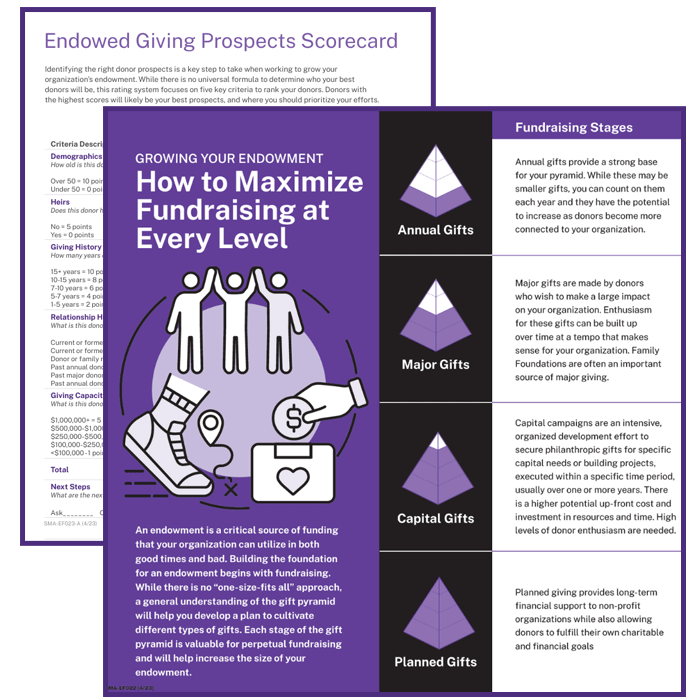A spending policy determines how much an endowment is permitted to withdraw from its portfolio to fund operations, capital projects, etc. A good spending policy should:
- Honor donor intent and support an organization’s mission
- Reflect an organization’s financial need and condition
- Permit some degree of predictability from year-to-year
- Allow spending to increase during the good times but be maintained to a degree during the difficult times
While there is no one size fits all approach to setting a policy, there are some general questions and guidelines that every endowment can answer and follow.
We can help
A spending policy plays an important role in managing an endowment. We can help ensure yours is set up to balance the withdrawals needed to support your spending needs today while also growing your investments to sustain your mission for years to come. Schedule a call today to learn more about all of the ways we can help your organization.
Connect with usWhat would donors think?
Endowed donors hope to see their contributions make a positive impact on an organization’s mission. Donor intent can be documented via a donor gift agreement – a promise between a donor and an organization that outlines the expectations that each party commits to when a gift is made. When assessing different spending policies, take the donor’s gift agreement into consideration and honor the donor’s intent. It is your responsibility to be good stewards of their gift by spending or reinvesting its proceeds appropriately.
What will best complement your other sources of revenue?
Organizations depend on their endowment to different degrees. Some schools, for example, can offer free tuition because their endowment makes up a large portion of their overall budget. In such a case, the predictability of that spending might be very important. In contrast, a social services organization like a food pantry might use its endowment for marginal operating support or longer-term strategic projects. This organization can probably afford to be more patient and flexible with how they spend from their endowment. Another consideration is how predictable your other sources of revenue are, including operating revenues, membership dues, annual gifts, and grants. An endowment can be used to complement these other sources of revenue depending on how you fine tune its spending policy.

Your roadmap to growing your endowment
If you’re looking for ways to effectively grow your organization’s endowment, our toolkit can help you get there! Featuring multiple donor outreach templates, an endowed giving prospect scorecard, infographics, and more, this toolkit is filled with actionable resources to help enhance your fundraising.
DownloadIs the purpose of your endowment to sustain or grow your mission?
Some organizations see their endowments as a tool for “equity” across different generations of beneficiaries. For example, a $1,000 annual scholarship to a student in year 1 needs to grow to a $1,304 scholarship in year 10 to have the same inflation-adjusted impact, assuming inflation of 3% per year. This implies a balance between spending today and growth for the future.
On the other hand, some endowments may be more strategic in nature. Perhaps an organization is saving for the long-term when they expect to undertake a major expansion in services or facilities. Money for this purpose is often “unrestricted” from a donor perspective, and therefore organization leaders have more flexibility to use assets as they see fit. In such a situation perhaps very little or no spending is occurring, and the portfolio can be positioned for capital growth over the long-term.
What does the law say?
Most donor endowed assets are governed by the Uniform Prudent Management of Institutional Funds Act (UPMIFA). Each state, except for Pennsylvania, has their own version of this law. UPMIFA provides a list of factors that must be considered when spending endowed assets – factors such as:
- the duration of the endowment,
- its purpose,
- the effects of inflation,
- and the other resources of the institution.
UPMIFA also states that an institution must “act in good faith, with the care that an ordinarily prudent person in a like position would exercise under similar circumstances.” Some versions hold that spending more than 7% of the value of an endowment in any one year creates a rebuttable presumption of imprudence.
How to Formalize a Spending Policy
Once an organization has answered these questions and found a rough consensus among decision-makers and stakeholders, they can formalize a spending policy by choosing a spending rule and a spending rate.
The Spending Rule is a formula for calculating the amount that can be spent. Common templates include (1) a percent of market value at a single point in time, (2) a percent of an average market value over multiple points in time, (3) beginning with a percent of the portfolio’s value and then adjusting that value over time for inflation, or (4) a hybrid approach combining any of the above.
The Spending Rate is the magnitude of spending each year, and typically ranges between 3% and 7%. The average effective spending rate in the 2022 NACUBO-TIAA Study of Endowments across all institutions in the study was 4.2%.
Clearly, spending rules differ in terms of how much variability might be expected in annual spending from year-to-year. Likewise, the higher the spending rate, the less will be kept invested to grow and compound over time, and vice versa. The key to creating a comprehensive spending policy is to choose a rule and rate that best balances your organization's goals and constraints as outlined in the questions above. For example, those with predictable operating revenues or smaller endowed support relative to their overall budget, may find they have the flexibility to allow for higher, less variable endowment spending. In contrast, organizations whose priority is to grow their assets may choose a more variable spending rule and a lower spending rate.
Lastly, it’s important to remember that your spending policy affects your investment policy. Higher magnitude, more stable spending needs might require a portfolio to prioritize capital preservation to a larger degree, while lower magnitude, less stable spending needs give most portfolios the flexibility to pursue more capital growth. You can help set your organization up for success with careful monitoring and coordination between spending and investment decisions, as well as “testing” different spending policies by modeling how they perform in various market environments.
There are lots of factors to consider, but by reflecting on the questions above, your organization can set an endowment spending policy that makes sense for your unique goals and risk constraints.
The information in this paper is not intended as legal or tax advice. Consult with an attorney or a tax or financial advisor regarding your specific legal, tax, estate planning, or financial situation.



